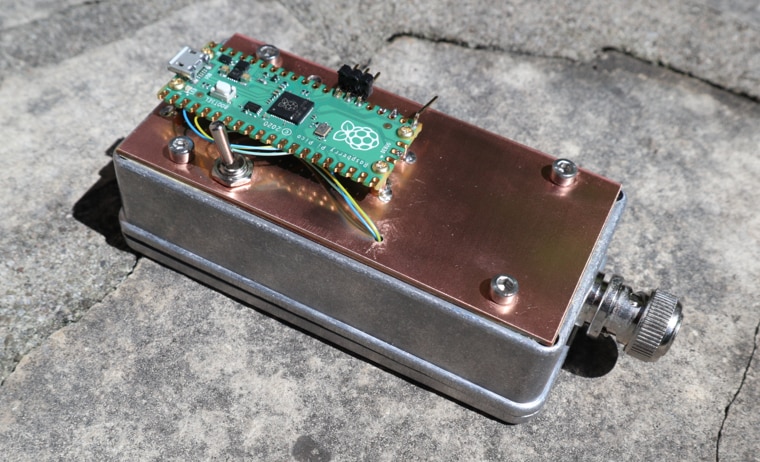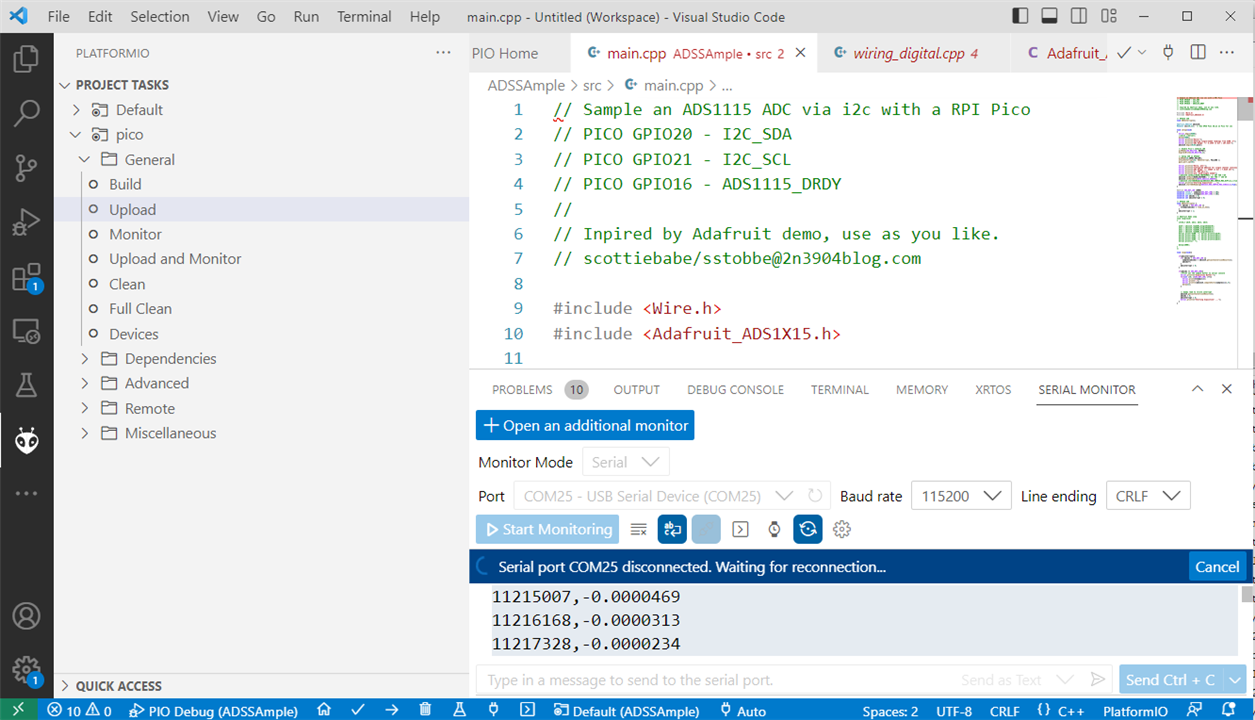I have never used an actual arduino board and have only tried the arduino framework on non-arduino hardware a few times.
I am putting together a little test box for an ADS1115 ADC module (or clone of New clone on the block )
Quite stuff inside the box, noisy stuff outside the diecast box, nothing fancy.

I am using a RPI Pico running the arduino framework using platformio

Here is the code I put together using Adafruits arduino library for the ADS1115
// Sample an ADS1115 ADC via i2c with a RPI Pico
// PICO GPIO20 - I2C_SDA
// PICO GPIO21 - I2C_SCL
// PICO GPIO16 - ADS1115_DRDY
//
// Inspired by Adafruit demo, use as you like.
// scottiebabe/sstobbe@2n3904blog.com
#include <Wire.h>
#include <Adafruit_ADS1X15.h>
// GPIO16 ISR
void ADSInterrupt();
Adafruit_ADS1115 ads1115;
MbedI2C i2c(20,21); // Use GPIO Pins 20,21 on Pico for i2c
void setup(void)
{
Serial.begin(9600);
//while (!Serial);
delay(1000);
Serial.println("Hello!");
Serial.println("Getting single-ended readings from AIN0..3");
Serial.println("ADC Range: +/- 6.144V (1 bit = 187.5uV)");
ads1115.begin(0x48,&i2c);
// Enable Pico's onboard LED
pinMode(LED_BUILTIN, OUTPUT);
digitalWrite(LED_BUILTIN,1);
// Setup ISR on GPIO16
pinMode(16,INPUT_PULLUP);
attachInterrupt(16, ADSInterrupt, FALLING );
gpio_pull_up(16);
Serial.println("Hello, pt2!");
Serial.println("Configured ADS1115 for single channel continuous conversion.");
Serial.println("ADC Range: +/- 256mV (1 bit = 7.8125 uV)");
Serial.println("Fs: 860 Sa/s");
Serial.println("Ain: Ain0-single ended");
//ads1115.setGain(GAIN_TWOTHIRDS); // SET FSR +-6V
ads1115.setGain(GAIN_SIXTEEN); // Set FSR +- 256 mV
ads1115.setDataRate(RATE_ADS1115_860SPS);
//ads1115.startADCReading(ADS1X15_REG_CONFIG_MUX_DIFF_0_1,true);
Serial.println("Starting Acquisition! ...");
ads1115.startADCReading(ADS1X15_REG_CONFIG_MUX_SINGLE_0,true);
}
#define ADS_BUF_LEN (4096)
volatile int16_t samples[ADS_BUF_LEN] = {0};
volatile uint32_t tstamps[ADS_BUF_LEN] = {0};
volatile int adsidx = 0;
volatile int adsinterrupt = 0;
// GPIO16 ISR
void ADSInterrupt() {
if( adsidx < ADS_BUF_LEN ){
tstamps[adsidx] = time_us_32();
}
adsinterrupt = 1;
}
/* Adafruit Demo Loop
void loop(void)
{
int16_t adc0, adc1, adc2, adc3;
adc0 = ads1115.readADC_SingleEnded(0);
adc1 = ads1115.readADC_SingleEnded(1);
adc2 = ads1115.readADC_SingleEnded(2);
adc3 = ads1115.readADC_SingleEnded(3);
Serial.print("AIN0: "); Serial.println(adc0);
Serial.print("AIN1: "); Serial.println(adc1);
Serial.print("AIN2: "); Serial.println(adc2);
Serial.print("AIN3: "); Serial.println(adc3);
Serial.println(" ");
delay(1000);
}
*/
void loop(void){
if(adsinterrupt){
if( adsidx < ADS_BUF_LEN ){
samples[adsidx] = ads1115.getLastConversionResults();
adsidx++;
}
adsinterrupt = 0;
}
if(adsidx >= ADS_BUF_LEN){
//Print out the sample buffer to serial console
Serial.println("Acquisition Buffer:");
for(int i=0; i<ADS_BUF_LEN; i++){
Serial.print(tstamps[i]);
Serial.print(",");
Serial.println(ads1115.computeVolts(samples[i]),7);
delay(1);
}
// dummy read to re-arm interrupt
ads1115.getLastConversionResults();
adsidx = 0;
adsinterrupt = 0;
Serial.println("Starting Acquisition! ...");
}
}
/



